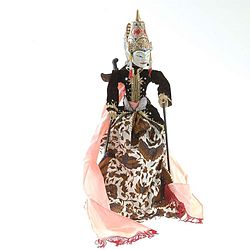Umro Ayyar
| Umro Ayyar | |
|---|---|
| First appearance | Hamzanama |
| In-universe information | |
| Nickname | Umro |
| Gender | Male |
| Weapon | Suleimani |
| Home | Tilism-e-Hoshruba |
Umro Ayyar or Amar Ayyar is a fictional character, an ayyār,[a] in Tilism-e-Hoshruba, an Urdu recension of the Islamic epic Hamzanama (originally in Persian). He was first written about during the time of Mughal Emperor Akbar and many stories and novels have been written about him since.[1][2]
Modern Urdu authors like Zaheer Ahmed,[3] Mazhar Kaleem,[4] Safdar Shaheen and Akhter Rizvi[5] have written various different stories about the character.
Summary
[edit]Umro Ayyar is a thief and most famous character of the Hamzanama after Amir Hamza, the titular hero of the epic. He's known for his cleverness and theft in the city 'Tilism-e-Hoshruba'. His life is full of adventure. It is his habit to travel around the world and to face evils and bad spirits. Umro has a magical zambeel (bag)[6] from which he can extract whatever he wants. He mostly uses it to show off and to kill evil. He steals from the rich and gives to the poor.
Legacy
[edit]
The immense popularity of the dastan had a long-lasting effect on other forms of fictional narratives. The earliest novels in Urdu as well as Hindi often seem nothing more than simplified or bowdlerized forms of Dastans. Babu Devaki Nandan Khatri's Chandrakanta and Chandrakanta Santati and Ratan Nath Dhar Sarshar's Fasana-e-Azad are only the two most stellar examples of this genre.[7] Chandrakanta bears the direct influence of dastans as witnessed in the case of eponymous protagonist Chandrakanta who is trapped in a tilism and the presence of notable ayyars. The dastan also influenced Munshi Premchand (1880-1936) who was fascinated and later on inspired by the stories of Tilism-e Hoshruba that he heard at the tobacconist shop in his childhood days. The conventions of the dastan narrative also conditioned Urdu theatre: the trickster Ayyar, permanent friend of Hamza provided the convention of the hero's [comic] sidekick that achieved culmination in the Hindi cinema of the sixties.
The story is also performed in Indonesian puppet theatre, where it is called Wayang Menak. Here, Hamza is also known as Wong Agung Jayeng Rana or Amir Ambyah.
Frances Pritchett's former student at Columbia University, Pasha Mohamad Khan, who currently teaches at McGill University, researches qissa/dastan (romances) and the art of dastan-goi (storytelling), including the Hamzanama.[8]In fiction
[edit]Films
[edit]| Film | Director | Played by |
|---|---|---|
| Chandrakanta (1956)[9] | G. P. Sippy | |
| Umro Ayyar - A New Beginning (2024) | Azfar Jafri | Usman Mukhtar[10] |
| Taalismaan (unreleased) | Ram Madhvani | Amitabh Bachchan |
Animated films
[edit]| Film | Director | Played by |
|---|---|---|
| The Chronicles of Umro Ayyar (unreleased) | Syed Arsalan Ali Haris Basharat[11] |
Afraz Rasool |
Dramas
[edit]| Drama | Writer | Played by |
|---|---|---|
| Ainak Wala Jin (1993) | Abdul Hameed | Nisar Butt[12] |
| Chandrakanta (1994)[13] | Devaki Nandan Khatri | Brahmachari |
| Kahani Chandrakanta Ki (2011) | Shrikant Vishvakarma | Sparsh Sharma |
| Chandrakanta (2017)[14] | Devaki Nandan Khatri Ekta Kapoor |
Punit Talreja |
| Prem Ya Paheli – Chandrakanta (2017)[15] | Devaki Nandan Khatri | Chandan K Anand |
Other books
[edit]| No. | Book | Writer(s) | Publisher |
|---|---|---|---|
| 1 | Hamzanama | Ghalib Lakhnavi | Modern Library |
| 2 | Chandrakanta | Devaki Nandan Khatri | Lehri Book Depot |
| 3 | Umru Ayar (comic series)[16] | Hasan Ansari | Kachee Goliyan |
| 4 | Tilism-e-Hoshruba[17] | Shahnaz Aijazuddin | Penguin Books Ltd |
| 5 | Hoshruba: The Land and the Tilism[18] | Musharraf Ali Farooqi | Penguin Random House Pvt. Ltd |
References
[edit]- ^ A class warriors and outlaws in the medieval Islamic world.
- ^ "Ayyar, ʻUmro (Fictitious character) [WorldCat Identities]".
- ^ Ahmad, Dr Saeed; Fatima, Ambar (1 March 2020). "عمر و عیار۔ داستانِ امیر حمزہ کا ایک دلچسپ کردار". Noor e Tahqeeq. 4 (13): 49–55 – via ojs.lgu.edu.pk.
- ^ "Umro Aur Botal Ka Jin by Zaheer Ahmed]". 7 July 2019.
- ^ "Umro Aur Veran Qila by Mazhar Kaleem M.A]".
- ^ "Tilism-i-Hoshruba: Umro Ayyar Collection Series".
- ^ "Zambeel – The legendary bag of tricks". Zambeel Dramatic Readings. 28 April 2013.
- ^ Introduction to Dastangoi. dastangoi.blogspot.com.
- ^ "Pasha M. Khan | Institute of Islamic Studies - McGill University". www.mcgill.ca. Retrieved 16 March 2016.
- ^ "Chandrakanta (1956)". Cinemaazi.
- ^ "Umro Ayyar: Usman Mukhtar revives the Persian legend of magic, adventure". Geo News. 17 November 2021.
- ^ "The Chronicles of Umro Ayyar". IMDb. 21 April 2023.
- ^ "NISAR BUTT in Ainak Wala Jin". FUN4ALL.
- ^ "Chandrakanta (1994)". Indiancine.ma.
- ^ "Chandrakanta (2017)". Indiancine.ma.
- ^ "Prem Ya Paheli: Chandrakanta (2017)". Indiancine.ma.
- ^ "Comic review: Umru Ayar, the rebirth of a hero". The Express Tribune. 28 April 2013.
- ^ Tilism-e-Hoshruba. Penguin UK. 30 October 2009. ISBN 9788184758245.
{{cite book}}:|website=ignored (help) - ^ "The Magical Tale of Hoshruba, a Dastangoi Classic". Asia Society.
